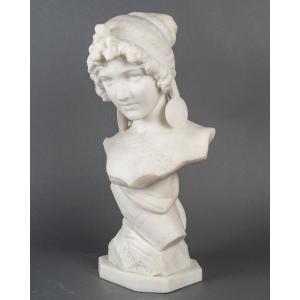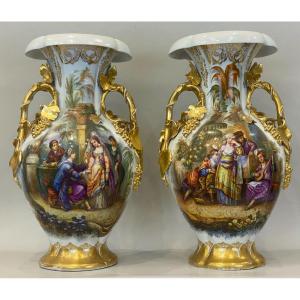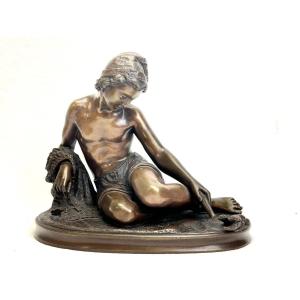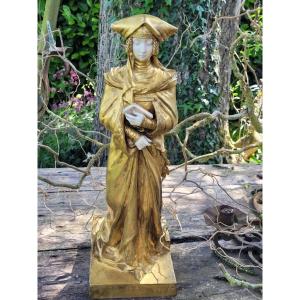Cast during the artist's lifetime with the foundry mark "F. Barbedienne fondeur" and the mechanical reduction stamp "Collas" on the base.
Circa 1890
Dimensions:
Height 62 cm
Width 26 cm
Depth 24 cm
Description:
Beautiful sculpture depicting a famous episode from Greek mythology: Orpheus, the mythical poet of Thrace, puts Cerberus, the three-headed dog that guards the entrance to the Underworld, to sleep.
Orpheus managed to enchant him by playing the lyre to bring his wife Eurydice back to the world of the living.
Orpheus had received the marvelous gift of music from his mother, so the gods gave him a lyre. Since then, he played the instrument whenever he wished, to the great pleasure of those around him.
The poet had no enemies, not even wild beasts: charmed, they always ended up lying at his feet. Of course, no young girl could resist the tender and soothing notes Orpheus created, but none found favor in his eyes, until the day he met the bewitching Eurydice. Their love was so deep and pure that they quickly decided to marry. But this happiness was short-lived.
The wedding was a celebration for all the guests, each rejoicing in the happiness of the young couple. But while she was out for some fresh air with her friends, Eurydice was bitten by a snake, and the meadow echoed with the screams of the terrified young girls.
Soon, Orpheus reached his beloved, who lay lifeless. The young man's face was transformed; He could not shed a single tear or cry, so great was his grief. How could he lose his wife on their wedding day? And how could he live without the one he passionately loved?
The thought was unbearable, so he decided to descend to the Underworld, the Kingdom of the Dead, to bring back his beloved.
The Underworld was populated by terrifying creatures, all subject to Hades, the god of the Earth's depths. He ruled over the dead, forbidding anyone who had entered his realm from leaving alive. This god was so terrible that the living did not even dare to speak his name! The entrance to his kingdom was guarded by Cerberus. Some say he had three heads, others fifty, and still others, more than a hundred! This terrifying dog remained chained before the gates of the Underworld to terrify the souls who sought to enter. But Orpheus had no trouble soothing the monster… A simple melody was enough to lull him to sleep, and he was able to pass through the gate without worry.
What he discovered next was hardly encouraging: the Underworld was a dark world, where wide, bottomless rivers flowed, a world where the menacing Erinyes sowed discord, terrorized, and punished at will.
But Orpheus was never worried. He progressed, protected by the sound of his lyre, and soon saw the palace of Hades and his wife Persephone appear. He entered without fear and presented himself before the gods. “What are you doing here?” asked Hades in his strong voice. Then, in response, Orpheus sang an incredibly sad song. The notes of his lyre filled all the halls of the palace, at first soft and melancholic, then loud and vibrant, like the poet’s pain. The whole thing, of course, was so enchanting that the infernal deities were appeased.
Hades and Persephone agreed to let Eurydice go. But they set one condition: as long as he was in the Realm of the Dead, Orpheus would not seek the woman he had come to seek. The young man happily agreed and set off, followed by his young wife.
Orpheus quickly saw daylight: they were finally about to leave the Underworld. But, while he was thinking about the happiness that awaited them, the young man forgot his promise and turned to gaze at his beloved. To his great misfortune, for the young girl immediately fell back into the abyss.
Orpheus had seen Eurydice for the last time! The poor boy was in despair. He tried once again to convince Hades to return his beloved. But he didn't get a second chance; the god remained unmoved by his pleas.
The poet then withdrew to a secluded place where he sang of his sorrow.
And no young girl could ever console him.
Biography of Raoul Verlet (1857-1923):
Raoul Verlet was born in Angoulême in 1857. He studied sculpture under Louis-Ernest Barrias and entered the École des Beaux-Arts in Paris, where he perfected his craft. He was one of the artists influenced by the neoclassical and academic movement, while incorporating a certain expressiveness into his works.
Career and Main Works:
Verlet became a renowned sculptor in the late 19th century. He participated in numerous Salons des Artistes Français, where he won several awards.


















































 Le Magazine de PROANTIC
Le Magazine de PROANTIC TRÉSORS Magazine
TRÉSORS Magazine Rivista Artiquariato
Rivista Artiquariato